|
Solving the Solar Neutrino Problem - by Ricky Leon Murphy:
Introduction
Early History and the
Standard Model
The Solar
Model and the first Neutrino Telescope
The Solar Neutrino Problem
Gaining Perspective
Sudbury Neutrino Detector
What Does This Mean?
The Future
Summary
References
Back to Solar System
Introduction:
In order to explain the Beta-decay process,
Wolfgang Pauli discusses an undetectable, mass less particle that
assists in carrying away energy. Enrico Fermi names it the neutrino.
Particle Physics defines the neutrino, and the solar model depends
greatly on its existence. After all, if fusion is occurring within the
core of the Sun, neutrinos are a natural by-product. The first
experiments in detecting the neutrino is successful, and John Bahcall
and Ray Davis predict the number of neutrinos emanating from the Sun,
and build an experiment to test the theory. The results are problematic.
Only one third of the neutrinos predicted are detected by this first
neutrino telescope. Continual study yields the same result. Other
detectors are built some time later only to confirm the result. Is the
Solar Model incorrect? Does something happen to the neutrinos? Is it a
question of detector sensitivity? With continued observation, only very
recently have these questions been answered. The most recent neutrino
telescope, the Sudbury Neutrino Observatory, has released data that
solves the Solar Neutrino Problem. While the Solar Model is preserved,
now the Standard Model is challenged.
Back to Top |
Back to Solar System
Early History and the Standard Model:
As with all things, there is a beginning. The year
is 1931, and Wolfgang Pauli explains the Beta-decay process for the
first time. In radioactive decay, a neutron breaks down into a proton,
electron, and missing energy. This process is called the Beta-decay (ß-decay).
This missing energy is carried away by an unseen, mass less particle
that Enrico Fermi later names the neutrino [R2].
Particle Physics is born.
Here is the ß-decay
(Kitchin,
page 149):
n
to
p+ + e- + νe[1]
In 1959 the challenge of detecting this enigmatic
particle was answered by Clyde Cowan and Fred Reines, whom design and
build a neutrino detector underground near a nuclear reactor in Hanford,
Washington [R5]
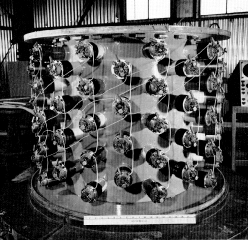
(Image Credit) |
This detector is filled with 400 liters of
water and cadmium chloride, and measures the interaction between
neutrinos emanating from the nuclear reactor and a proton within
the nucleus of the cadmium atom. The neutrino interaction was
captured by photo-detectors as a flash of light lasting just a
fraction of a second [R5].
The experiment was a complete success, and the neutrino was
detected for the first time.
|
This early method of detecting sub-atomic particles
paved the way to countless future experiments in an attempt to identify
all sub-atomic particles. By the 1970’s, a unified theory of sub-atomic
particles was released. This theory, called the Standard Model, has
lasted even through today [R6].
While the theory itself is rather complex, the basic premise is not. All
matter as we know it today is comprised of any combination of 12
fundamental particles. The word ‘fundamental’ in this case means the
particle cannot be broken down into smaller parts. Here are the 12:
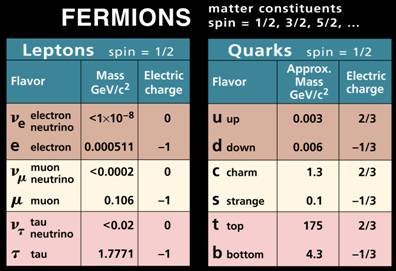 |
The bottom two rows belong to the
Generation II and Generation III group, consecutively. The first
row are Generation I particles. Protons and neutrons are a
combination of three ‘up’ and ‘down’ quarks. The electron is a
fundamental particle along with its partner, the electron
neutrino.
(Image Credit)
|
According to the Standard Model, particles in the
Generation III column decay to the Generation II column. Likewise, the
particles in the Generation II column decay into the particles in the
Generation I column [R6].
In other words, the tau particle decays to a muon particle releasing a
tau neutrino. Likewise, the muon decays to an electron releasing a muon
neutrino. This is important to remember as this will be challenged later
by the solar neutrino experiments.
What does the Standard Model say about neutrinos [R10]?
- Neutrinos have very little or no mass.
- There are three “flavors:” Electron neutrino,
muon neutrino, and tau neutrino.
- Neutrinos have no electric charge.
- Neutrinos have a spin of ½.
- Neutrinos have weak interactions, meaning they
can pass though the Earth unimpeded.
- Neutrinos have an associated anti-neutrino
that spins opposite, with the following rule: a neutrino spins left
and an anti-neutrino spins right.
Back to Top |
Back to Solar System
The Solar
Model and the first Neutrino Telescope:
The Sun’s energy is generated by the fusion of
hydrogen into helium in the core. The process of this fusion is called
the Proton-Proton Chain. The initial theory of this fusion process was
designed by Hans Beth in the 1930’s [R2]
and later expanded by John Bahcall [R8].
The expanded Solar Model allowed for the prediction of neutrinos
emanating from the Sun per second. Knowing this, the Inverse Square Law
can be applied to predict the flux per meter square here on Earth. Based
on the Proton-Proton Chain, or P-P chain, the core of the Sun produces
1038 neutrinos per second. Bahcall predicted that 1011
neutrinos per meter square here on Earth (Universe,
page 398). There are actually three sources of neutrinos by fusion
processes within the Sun’s core [R8]
[R1]:
The First Process:
1H+
+ 1H+
to 2H+ +
e+ + νe
e+
+ e- to
2γ
Two Hydrogen protons are fused to create deuterium
(2H), a positron (e+), and an electron neutrino (νe).
The positron annihilates into an electron and creates two gamma rays.
1H+ + 2H+
to
3He++
+ γ
A single Hydrogen proton is fused to the newly
created Deuterium and creates a light isotope of Helium (3He)
and a gamma ray.
3He++ + 3He++
to
4He++ + 1H+ + 1H+
Two of the light isotopes of Helium are fused to
form the “normal” Helium atom and two extra Hydrogen protons. This
entire process provides 85% of the supplied neutrino flux.
The Second Process:
3He++
+ 4He++ to 7Be+ +γ
Helium and light helium fuse to form beryllium (7Be+)
and a gamma ray.
7Be+ + e-
to
7Li
+ νe
Beryllium adds an electron to form lithium (7Li),
and releases an electron neutrino.
7Li + 1H+
to 4He++
+ 4He++
The lithium adds a photon of hydrogen to split to
two helium atoms. This entire process releases only 15% of the neutrino
flux.
The Third Process:
3He++
+ 4He++ to 7Be + γ
Light helium and helium fuse to form beryllium and
a gamma ray.
7Be + 1H
to
8B + γ
The beryllium fuses to a hydrogen proton to create
boron (8B) and a gamma ray.
8B
to 8Be + e+
+ νe
The boron is unstable and releases an electron and
an electron neutrino to become beryllium once again.
8Be
to 4He++ +
4He++
The remaining beryllium continues to remain
instable, and breaks apart into a pair of helium. This entire process
only releases 0.02% of the total neutrino flux.
This is the solar model in its entirety. Based on
the above predictions of neutrino flux, John Bahcall and Ray Davis begin
to construct the first experiment to detect solar neutrinos. To build
such a detector, a location needed to be found, and a medium in which to
capture the neutrino needed to be selected. Since neutrinos have weak
interactions, they can pass straight through the Earth with little
difficulty (Kitchin,
page 149). On the other hand, other radiation cannot travel though the
Earth. The perfect location for any neutrino detector is deep under the
surface. The choice for the first neutrino detector was Homestake gold
mine in South Dakota. As suggested by Bruno Pontecorvo and Luis Alvarez
in the 1940’s [R2],
a chlorine solution was chosen to capture neutrinos.
Here is the Homestake Neutrino Detector (otherwise
known as the Brookhaven Solar Neutrino Observatory):
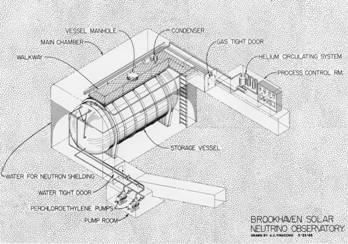 |
Since such a large amount of liquid (600
tons) was required, a relatively inexpensive chemical was chose.
Standard dry-cleaning solvent (tetrachloroethene) was perfect
since it was available in such large quantities.
As the neutrino collides with the chlorine
atom, the added energy creates an argon atom. As the argon
looses energy, helium is released and bubbles to the surface.
(Image Credit)
|
These reactions were counted to indicate the number
of neutrinos reacting in the chamber. This particular chamber is called
a Chlorine 37 detector (Kitchin,
page 151). Because of the fairly low sensitivity of this detector, the
neutrino flux is measured from this high energy source:
8B
to
8Be + e+ + νe
by the following reaction:
νe
+ 37Cl to 37Ar + e-
The results proved that neutrinos emanating from
the Sun do exist, but the number of neutrinos detected here on Earth,
called the flux, was one-third the number of predicted neutrinos.
- Could the model of solar fusion be incorrect?
- Could the method of detection be incorrect?
The culmination of the results taken from Homestake
inexorably created the “Solar Neutrino Problem.”
Back to Top |
Back to Solar System
The Solar
Neutrino Problem and the next generation detectors:
For more than two decades, the answer to the Solar
Neutrino Problem remained unsolved. Realizing the possibility that
sensitivity might be the cause of the problem, two experiments were
designed to detect neutrinos of a lower energy. These detectors are
identical in their design, but different in overall capacity.
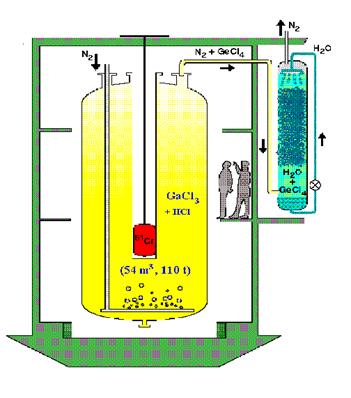 |
Using 60 tons of liquid metallic gallium,
the SAGE (Soviet-American Gallium Experiment) detector is
designed to look for the reaction [R7]:
71Ga + νe
to 71Ge
+ e-
By counting the radioactive atoms of
germanium, the neutrino flux is calculated.
An identical experiment in Italy, called
GALLEX (GALLium EXperiment), used only 30 tons of gallium.
Both of these experiments, although more sensitive, supported
the Davis experiment by only detecting 50 to 60% of the neutrino
flux [R8].
(Image Credit)
|
Two other detectors using water as the media, while
originally designed to examine proton decay, proved successful in
detecting solar neutrinos. The Kamiokande and the IMB
(Irvine-Michigan-Brookhaven) detectors are underground water tanks lined
with a tremendous number of photomultiplier tubes. The Kamiokande weighs
in at 3000 tons while the IMB weighs in at a tremendous 8000 tones.
Because of this design, there is an added benefit: the direction of the
neutrino interacting with the water molecules can be tracked.
The detection method is looking for what is called
the Cherenkov effect. When a neutrino interacts with a proton within the
water molecule, an inverse ß-decay
occurs (Kitchin,
page 153). This is the reaction:
νe
+ p to n + e+
The positron (e+) is released in the
same direction of the neutrino, with a speed in excess of the speed of
light in water – which is 225,000 km/s (Kitchin,
page 153). This creates an optical shock-wave called Cherenkov
radiation. These effects are counted to determine neutrino flux.
The sensitivity of both detectors was enough to
study the flood of neutrinos emanating from a supernova – SN1987A. While
sensitive in their ability to detect neutrinos from such a distance, the
measure of the solar neutrino flux agrees with all previous solar
neutrino experiments. With the added benefit of determining the
direction of the neutrino, solid evidence was presented that the source
is indeed the core of the Sun.
In order
to further increase sensitivity, the groups responsible for Kamiokande
and IMB joined forces to design and build the Super-Kamiokande Neutrino
Observatory.
 |
Based on the success of the previous
water-based experiments, the Super-Kamiokande contains and
enormous 50,000 tons of water. In the shape of a cylinder,
photomultiplier tubes line the inside cylinder wall, the floor,
and the ceiling of the detector.
With such a large capture area, this
detector was able to detect muon neutrinos emanating from the
Sun.
While the results still counted only 55% of
the total neutrino flux, the detection of the muon neutrino gave
the first clue that neutrinos might be oscillating [R10].
In a sad turn of events, tragedy struck the
Super-Kamiokande detector on November 12, 2001. A single
photo-detector imploded creating a shockwave that damaged
several thousand photo-detectors. The damage was repaired, and
the detector has begun operations on January 18, 2003
(http://dumand.phys.washington.edu/~superk/.
(Images
Credit)
|
Back to Top |
Back to Solar System
Gaining perspective: The results so
far.
Over 20 years have spanned, and a solution to the
Solar Neutrino Problem has not been found. However, the technologies
have improved and the culmination of these results will lead to a final
solution.
The results matrix (hyperlinks
attached to detector name links to the appropriate homepage):
| Detector |
Date of Operation1 |
%
of flux1 |
neutrino energy |
Directional |
| Homestake |
1970 - 1995 |
33% |
High energy |
No |
| SAGE |
1990 - 2006 |
58% |
Low energy |
No |
| GALLEX |
1991 - 1996 |
60% |
Low energy |
No |
| IMB |
1982 - 19912 |
51% |
Low energy |
Yes |
| Kamiokande |
1986 - 1995 |
54% |
Low energy |
Yes |
| Super-Kamiokande |
1995 - |
47% |
Low energy |
Yes |
1Data
from:
http://cupp.oulu.fi/neutrino/nd-sol2.html
2Data
from:
http://www.phys.cmu.edu/~clark/imb.html
The results so far agree with the Solar Neutrino
Problem. There are not enough neutrinos detected to justify the current
solar model. Several possible solutions are:
- The core temperature of the Sun is 10% less
that the predicted value.
- Something is happening to the neutrinos
between the Sun and Earth.
- Neutrinos may be oscillating between flavors.
While a 10% reduction in core temperature would
agree with the predicted neutrino flux, other effects would follow. For
example, a 10% reduction in core temperature would conflict with Wien’s
Law – or the relationship between wavelength and temperature (Universe,
page 101).
Since neutrinos are weak interactive particles,
there is little to affect their trajectory, so something happening to
the neutrinos between the Sun and Earth is highly unlikely based on the
Standard Model.
The idea that neutrinos oscillate, that is change
from electron neutrino to muon neutrino to tau neutrino at random, has
gained favor since the Super-Kamiokande was able to detect a muon
neutrino coming from the Sun. The Sudbury Neutrino Observatory would
support this idea [R10].
Back to Top |
Back to Solar System
The
Sudbury Neutrino Observatory to the rescue:
The Sudbury Neutrino Observatory, or SNO, is built
deep underground in Creighton mine in Sudbury, Ontario. This observatory
is different from the other neutrino detectors as this one uses heavy
water, and is actually capable of detecting all three “flavors” of
neutrinos [R9].
 |
The detector consists of 1000 tons of very
pure heavy water in a 12 meter sphere. This sphere is enclosed
in a clear plastic sphere 22 meters in diameter and is suspended
by ultra-pure regular water. Surrounding that sphere is a
geodesic sphere containing over 9000 photomultiplier tubes [R9].
Just like the Kamiokande, IMB and Super-Kamiokande
detectors, the SNO is looking for the Cherenkov radiation
emitted by neutrino interactions.
The detector was completed, and began
operation in November 1999. The first scientific results were
released in June 2001. These first results confirmed the
oscillating nature of the neutrino [R9].
(Image borrowed from:
http://www.sno.phy.queensu.ca/)
|
|
The detector is designed to look for three
different reactions. This is the reason for its sensitivity.
These reactions are [R9]:
Charged Current Reaction (CC):
ve + d
to p + p + e-
Neutral Current Reaction (NC):
vx[2] + d to p + n + vx
Elastic Scattering Reaction (EC):
vx + e-
to vx + e-
The CC reaction is very sensitive to the
electron neutrinos, while the NC (the most sensitive) and the EC
reactions are sensitive to all three “flavors.” |
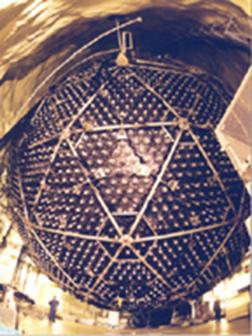 |
The results as of June 2001 show that the total
number of all neutrinos matches the predict flux first theorized by John
Bahcall. According to this experiment, the Solar Neutrino Problem has
been solved [R3].
In order to test and repeat these results, the SNO
performed another experiment called “Day versus Night.”. Basically, the
observatory wanted to rule out any possibility of additional
radioactivity that could have skewed the result. The results released in
April 2002 matches the initial result in 2001. In addition, the number
of electron neutrinos counted by this experiment totaled 1/3 of the
total number of neutrinos. This is proof that oscillation is occurring
between all three “flavors” of neutrinos [R9].
In May of 2003, two tons of ultra-pure table salt (NaCl)
was added to the SNO detector to improve the NC reaction sensitivity [R4].
The result is an increase in detector sensitivity three-fold. On
September 7, 2003, a press release was issued by the SNO that confirmed
the initial results showing that neutrinos do indeed oscillate between
all three “flavors.”
Back to Top |
Back to Solar System
What do
these results mean?:
The results from SNO show:
- The total number of neutrinos detected equal
the total of neutrinos predicted.
- The Solar Model is correct – fusion is the
source of energy within the Sun.
- Neutrinos oscillate between electron neutrino,
muon neutrino and tau neutrino.
- The increased sensitivity of SNO allowed
detection of all three neutrinos.
What does this mean for the Standard Model? In the
spirit of the scientific method, these results need to be tested and
compared to further experiments from particle physics. The
contradictions SNO creates for the Standard Model are:
- All three “flavors” of neutrinos are detected
emanating from the Sun’s core. According to the Standard Model,
neutrinos are released when their companion particle decays towards
the Generation I particle.
- According to SNO, neutrinos oscillate between
“flavors” indicating that neutrinos have mass. The Standard Model
states that neutrinos do not have mass.
Back to Top |
Back to Solar System
What the future
holds:
Other elements are believed to be even more
sensitive in detecting neutrinos. While such telescopes are yet to be
constructed, Iridium, Lithium, and Potassium-Hydroxide are thought to
provide a more sensitive media, but cost and availability could hinder
such projects (Kitchin,
page 155 to 157). So far, our current ability to detect neutrinos is
only possible from the Sun, supernova, failed supernovae, and know
Gamma-Ray Bursts (GRB’s).
Since neutrino oscillation has presented itself,
one future project bear mentioning. A worldwide collaboration project is
in the design phases. Laboratories in France, Germany, Italy, Russia,
Japan, and the United State are working on the LENS project, or Low
Energy Neutrino Spectroscopy. This detector will be using the following
reaction [R11]:
νe
+ 176Yb to 176Lu*
+ e-
then to
176Lu + g
It is thought that this reaction is stable enough
to allow real-time analysis of a neutrino. The sensitivity of this
detector will allow the study of the least energetic neutrino, the ones
from the initial P-P chain [R11].
Back to Top |
Back to Solar System
Summary:
The study of the neutrino is an excellent example
of the scientific process. An idea is proposed to explain a process – in
this case, an explanation was proposed for the
ß-decay. A theory is formulated
and experiments are designed to test the result. Neutrinos were
invented, theorized and later proved by experimentation. A model (which
is a theory with a design that is accepted) of energy production within
the core of the Sun was also tested by experimentation by detecting
neutrinos. While the initial flux did not match theoretical limits, the
experimentation continued. Improvements in detector design allowed more
sensitive measurements, and the persistence in testing ultimately
resulting in detecting the theoretical flux. The Solar Model was proven
to be correct: hydrogen protons are fused together to form helium with a
release of energy and neutrinos. Also in the spirit of the scientific
method, other observatories are designing alternate versions of neutrino
detectors to continue studying them. Just as the experimentation to
prove the existence of the neutrino led to neutrino detectors to study
the fusion process within the Sun, new designs in neutrino detectors may
allow studying neutrinos from other sources such as: gamma ray bursts,
supernova, and cosmic background radiation. Perhaps these new detectors
will allow us to see the theoretical neutrinos as an ingredient to Dark
Matter. In the mean time, Astronomers can now cross the Solar Neutrino
Problem off their lists.
Back to Top |
Back to Solar System
References:
[R1]
Bahcall, John. Solar Neutrinos:
http://www.sns.ias.edu/~jnb
[R2]
Boyle, Alison and Grimes, Ken. “Ghostbusting the Universe.” Astronomy
Magazine December 2003: 44 – 49.
Freedman, Roger A. Universe: 6th Edition. W.H.
Freeman and Company, 2002
[R3]
Foust, Jeff. “Solar Neutrino Problem Solved.” Spaceflightnow.com.
Online June 20, 2001.
Kitchin,
C R. Astrophysical Techniques: Third Edition. Institute of
Physics Publishing, Bristol and Philadelphia, 1998.
[R4] The
Particle Physics and Astronomy Research Council:
http://www.pparc.ac.uk/Nw/Press/sudburysalt.asp
[R5]
Neutrino History:
http://wwwlapp.in2p3.fr/neutrinos/anhistory.html
[R6]
Quinn, Helen. “Theory. Leptons.” Virtual Visitors Center. Online.
05 May 2003.
[R7]
Solar Neutrinos:
http://zebu.uoregon.edu/~soper/Sun/solarneutrinos.html
[R8]
Solar Neutrinos: Theory:
http://cupp.oulu.fi/neutrino/nd-sol1.html
[R9]The
Sudbury Neutrino Observatory:
http://www.sno.phy.queensu.ca/
[R10]
What’s a Neutrino:
http://www.ps.uci.edu/~superk/neutrino.html
[R11]
Low Energy Neutrino Spectroscopy:
http://lens.in2p3.fr/
[1] n = neutron; p = proton; e = electron; ve
= electron neutrino
[2]
x = electron (e), muon (µ),
tau (t)
neutrinos
Back to Top |
Back to Solar System |

